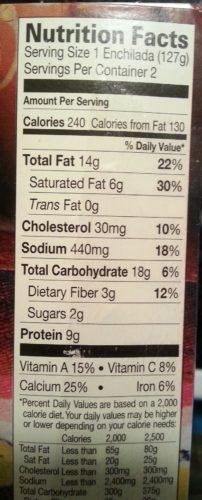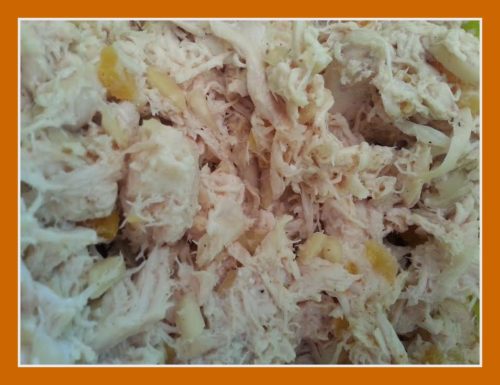So March is ending and with it the celebration of National Nutrition Month. Well, we don’t really let Nutrition Month ever end! We need to be alert and focused on our health at all times. That’s not to say we can’t enjoy our favorite “not so healthy” foods every now and then.
I bring this up to point out an interesting find Angie made. Angie was traveling this week and had to stay in hotels. She found one that had a freezer and microwave which would allow her to “prepare” her own meals and not eat out as much. She decided to find some healthy, single serve frozen entrees and add frozen vegetables to them to enhance the nutrition profile of the meal. Along with the added vegetables, Angie also added a piece of fruit to the meal. If you are not careful, using frozen meals will result in a high sodium, fat, and calorie meal.
Angie found some ni ce entrees to use and enjoyed them. She found
ce entrees to use and enjoyed them. She found the “Amy’s Gluten Free, No GMO, Cheese Enchilada, Made with Organic Tortillas & Tomatoes”, with other single serve frozen items and glanced at the Nutrition Facts. Once she got to her hotel room and started preparing her meal, she realized the small package was actually contained 2 servings! Instead of getting 440 mg of sodium, she consumed 880 mg. We generally counsel clients to keep sodium goals to 2000 mg a day or 500-600 mg per meal. While she did not exceed her overall daily sodium intake for the day by too much, that was an excessive amount for her at one meal. And for the record, no, Angie did not purchase the item because of the gluten free, organic ingredients and No GMO claims!
the “Amy’s Gluten Free, No GMO, Cheese Enchilada, Made with Organic Tortillas & Tomatoes”, with other single serve frozen items and glanced at the Nutrition Facts. Once she got to her hotel room and started preparing her meal, she realized the small package was actually contained 2 servings! Instead of getting 440 mg of sodium, she consumed 880 mg. We generally counsel clients to keep sodium goals to 2000 mg a day or 500-600 mg per meal. While she did not exceed her overall daily sodium intake for the day by too much, that was an excessive amount for her at one meal. And for the record, no, Angie did not purchase the item because of the gluten free, organic ingredients and No GMO claims!
We often say that you can’t judge a book (or packaged food) by its cover. Unfortunately, its the cover that usually sells the book (or food)! So be alert when you shop. Have a plan and know what you are looking for in your meals. We’ve included a guide, Finding a Healthy Frozen Meal, Finding a Healthy Frozen Meal to help you choose frozen meals and stay within your dietary guidelines.
Keep celebrating Nutrition Month each day to help you reach the health you want. Add in some extra activity and you’ll be on your way. Never forget, you hold the keys to better health!
It’s Your Health. It’s Your Life. Make That Change!
~John
 It’s almost the end of January which means it’s a good time to check and make sure you’re staying on track with the health and fitness resolutions that you had in mind on December 31st. How is your progress going? If you have not yet been successful, you are not alone!
It’s almost the end of January which means it’s a good time to check and make sure you’re staying on track with the health and fitness resolutions that you had in mind on December 31st. How is your progress going? If you have not yet been successful, you are not alone!








